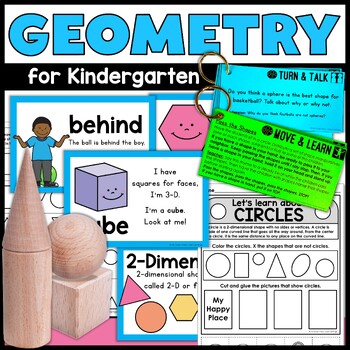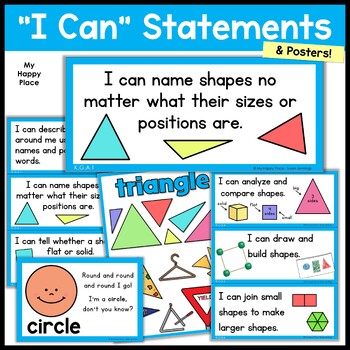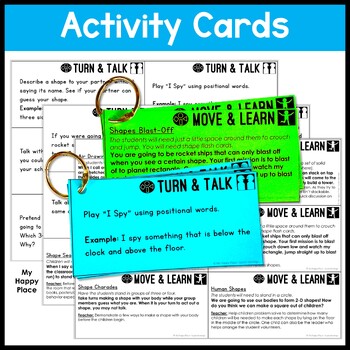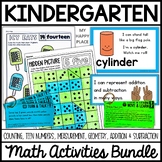2D and 3D Shapes and Positional Words - Kindergarten Geometry Activities
- PDF
What educators are saying
Also included in
- This kindergarten math bundle is packed with materials to help you teach five units: Counting and Cardinality (numbers 1-10), Teen Numbers, Geometry (2D & 3D shapes and positional words), Measurement, and Addition and Subtraction. With worksheets, activity cards, anchor charts, posters, and morePrice $18.00Original Price $22.50Save $4.50
Description
Help your kindergarten students master 2D and 3D shapes and positional words with this collection of kindergarten geometry worksheets and teaching tools. This set is designed to support your students as they learn and practice math vocabulary, comparing shape attributes, identifying shapes in the environment, composing shapes, and other beginning geometry concepts.
Perfect for small- and whole-group work, this kindergarten geometry set can also be used as independent practice, morning work, or homework. These materials are aligned with the Common Core kindergarten standards for geometry but contain useful tools for any class learning about shapes and positional words. This resource also includes “I Can” statements, posters, flashcards, and more!
What does this kindergarten geometry set include?
This kindergarten math set is designed to give students meaningful practice with beginning geometry concepts and vocabulary:
✔ Illustrated 2D and 3D Shapes Posters
These nine posters illustrate examples of the following geometric shapes: square, circle, triangle, rectangle, hexagon, cube, sphere, cone, and cylinder.
✔ Illustrated “I Can” Statements (Aligned to CCSS)
These six statements are written in child-friendly language and are useful for providing a focus point for each lesson. These statements are aligned to the Common Core Geometry Standards.
✔ “Turn and Talk” Activity Cards
Each of these nine cards provides an oral language prompt to promote the development of math vocabulary and to give students experience with explaining their thinking and reasoning.
✔ “Move and Learn” Activity Cards
Each of these nine cards includes a movement activity that allows students to engage their bodies while practicing a kindergarten geometry concept. These activities are great for carpet time, transitions, and for quick review throughout the year.
✔ Positional Words and Shapes Cards
Cards for display include illustrations and text to help students internalize geometry concepts. Flashcards (and labels) are great for carpet time and for matching activities.
✔ Geometry Picture Prompts
This section contains picture prompts to get students using geometry vocabulary orally and in writing. In this section, you’ll find:
•2 Full-Color Picture Prompts: These can be projected in a whole-group setting or printed and shared with a small group. Have students talk about the scenes using geometry vocabulary (positional words and shapes)
•Picture Prompt Writing Pages: Each picture prompt is also included in a black and white version for writing. These pages come with labels for the pictures, a vocabulary bank, and two different line styles (choose which works best for your students).
✔ Printable Worksheets
These 41 printable worksheets give students ample practice in a variety of kindergarten geometry concepts.
▶ 3 Worksheets for Each 2D and 3D Shape
For each of the nine included shapes, this set has three practice pages. These pages follow the same format from shape to shape to allow for consistency and independence.
▶ 13 Additional Geometry Printables
These pages allow students to practice sorting and examining shapes. Some of the pages have students cut and glue and others include pencil tasks. See the preview file for more detail!
How to Use These Kindergarten Geometry Printables:
The materials included in this kindergarten math set can be used to supplement your teaching of geometry standards. Introduce the shape posters and positional words vocabulary cards to students before displaying them in the classroom. As you introduce each shape or concept, have students brainstorm real-world examples and practice using the vocabulary in sentences. Then place the visual aids where students can easily reference them. As you work through the unit, model referencing the word cards and posters.
Use the “Turn and Talk” and “Move and Learn” cards to introduce and/or close out your geometry lessons. These cards engage all students and give them opportunities to use their shape and positional words vocabulary. They also work well as brain breaks and transition activities throughout the day.
Looking for hands-on practice? Here’s a set of kindergarten geometry centers!
What teachers are saying about this kindergarten geometry unit:
⭐⭐⭐⭐⭐ “This is a great resource. The word cards are perfect for a math word wall. The “I can statements” and worksheets are great supplements to my math program.” –Diane W.
⭐⭐⭐⭐⭐ “I have now bought all of the units! Should have just bought the bundle! I love the student practice pages along with all of the visuals! BUY THEM!!!” –Courtney I.
⭐⭐⭐⭐⭐ “Super easy to follow and the lesson went off so smoothly as I literally didn't need to use the textbook for the lesson; all was included!! A must have!!” –Tova G.
You may also like:
▶ Kindergarten Geometry Centers
▶ Shapes in the Environment Slideshow
▶ Teen Numbers for Kindergarten
▶ Counting and Cardinality for Kindergarten
Please see the preview file for more detailed images. If you have any questions, email susan@myhappyplaceteaching.com or use the “Q&A” feature on this page.
I would love to have you as a follower! Click the green star to be the first to know about new resources.
Thank you for shopping!
Susan Jennings (My Happy Place)
Copyright © My Happy Place Teaching Resources
Permission to copy for single classroom use only.
Please purchase additional licenses if you intend to share this product.






